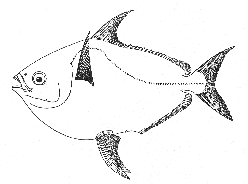Opah Lampris regius (Bonnaterre) 1788
MOONFISH; JERUSALEM HADDOCK
[Jordan and Evermann, 1896-1900, p. 954, as Lampris luna (Gmelin) 1789.]

Figure 122.—Opah (Lampris regius). After Goode and Bean.
Description—
The thin, deep form of the opah (trunk less than twice as long as it is deep) with moderately slender caudal peduncle, which does not have longitudinal keels, and the rather pointed snout, might suggest an enormous butterfish, were it not provided with very long falcate ventral fins, whereas the butterfish has no ventrals. The ventrals, also, of the opah have 14 to 17 rays; none of the mackerel or pompano tribes has more than 8.
The forward part of the single dorsal fin (53 to 55 rays) is high, its outlines strongly falcate. The anal (38-41 rays) is shorter than the dorsal, and it is about equal in height to the low part of the dorsal throughout its length. Both anal and dorsal fins extend back close to the base of the caudal fin, and each of them is depressible in a groove. The tail fin is emarginate, the pectorals are conspicuously pointed, with their bases horizontal instead of vertical. The mouth is small and toothless, the scales are minute, and the lateral line is strongly arched upward above the pectoral fin, then downward toward the rear.
Color—
We have never seen this fish alive, but it is described as of a beautiful dark steel blue above, shading into green with silver, purple, gold, and lilac luster down the sides, and as rosy on the belly, with vermilion fins, while the whole body is speckled with silvery and milk-white spots.
Size—
The opah grows to a length of 3 to 6 feet; most of them are 3 to 4 feet long.
Habits—
The opah is usually spoken of as a deep-sea fish, but this is a misnomer, for it is caught on hook and line no deeper than 50 to 100 fathoms off Madeira, where it is taken in some numbers. Being so very rare off our coast, we need merely note that it feeds chiefly on squid, isopods, and small fish, as well as on seaweeds; that it is an excellent food fish; and that nothing is known of its breeding habits.
General range—
Open waters of the Atlantic and Pacific Oceans; recorded off Madeira, Scandinavia, the British Isles, Norway, Iceland, Newfoundland, Nova Scotia, Maine, Cape Cod, and Cuba in the North Atlantic; also in the Gulf of Mexico off the west coast of Florida.
Occurrence in the Gulf of Maine—
Two specimens, only, of this oceanic wanderer have been reported definitely within the limits of our Gulf, one caught on a long line on Browns Bank in the spring of 1932[12] the other, weighing 165 pounds fresh, was taken in an otter trawl on the northeastern part of Georges Bank, in August 1947.[13]
One also was reported from Maine by Goode and Bean,[14] but this may have been based on a letter to D. S. Jordan from Everett Smith, July 19, 1888, reporting that a "Sun Fish," identified [page 248] as an opah by the included description and sketch, had been landed in Portland, Maine, from the Grand Banks.[15]
One was caught off Sable Island, Nova Scotia, about 1856, and another off La Have Bank many years ago;[16] a specimen about 3 feet long was taken in July 1925 on Western Bank, southwest of Sable Island, by the schooner Falmouth;[17] and another of the same size stranded on the beach at Hyannis, Mass., on September 17, 1928.[18]
[12] Reported by Vladykov, Proc. Nova Scotia Inst. Sci., vol. 19. 1935, p. 6.
[13] This specimen is in the Museum of Comparative Zoology.
[14] Goode and Bean, Smithsonian Contrib. Knowl., vol. 30, 1895, p. 223.
[15] We are indebted to Norman J. Wilimovsky for showing us a copy of this letter.
[16] Vladykov, Proc. Nova Scotia Inst. Sci., vol. 19, 1935, p. 6.
[17] Radcliffe, Copeia, No. 151, 1926, p. 112.
[18] Reported by Robert Goffin of the Bureau of Fisheries station at Woods Hole, Mass.